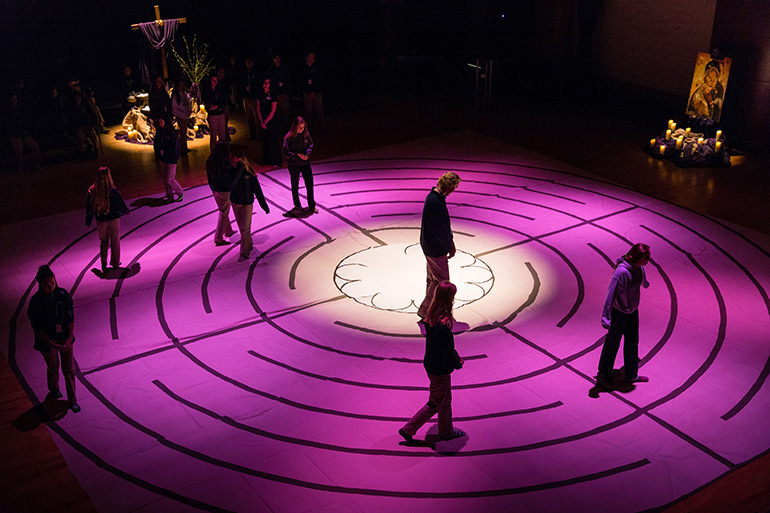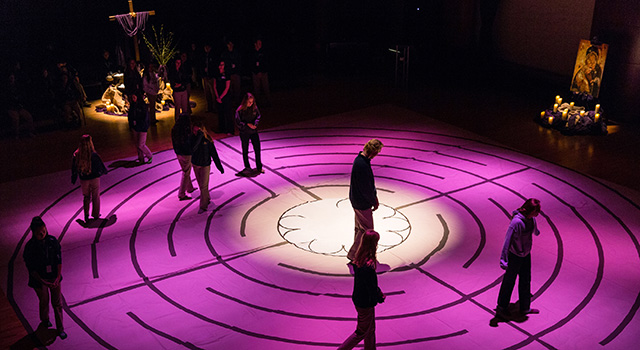By Cynthia Thuma - Florida Catholic

Photographer: FILE | TOM TRACY
Students take part in a Lenten Labyrinth faith walk and prayer experience in this file photo from March 2017 at St. Thomas Aquinas High School in Fort Lauderdale. The labyrinth is part of the school’s campus ministry and liturgical ministry Lenten programming.
FORT LAUDERDALE | For the past seven to eight years, students at St. Thomas Aquinas High School could intensify their Lenten experience by walking the school’s labyrinth, which functioned as part of the campus ministry program.
A few years ago, the school opened the labyrinth to the public, allowing them to share in the intensely spiritual experience.
“I went to one last year,” said Aquinas student Nehry Celoge, 16. “It was very dark inside, very spiritual and you go through slowly.”
The experience, she said, was both intense and powerful.
“Those are the words we hear with the kids, powerful and peaceful,” said Aquinas theology teacher Marianne Jones.

Photographer: FILE | TOM TRACY
The custom-built labyrinth at St. Thomas Aquinas High School is surrounded by reproductions of ancient icons. It was open March 13-20, 2018 at the Bienes Center for the Arts, across the street from the high school.
“I think that sometimes it’s a transformational experience for our students,” said theology teacher Michael McCormack.
Both Jones and McCormack are among the directors of the school’s Lenten Labyrinth experience.
So just what is a labyrinth? A labyrinth is a winding path, moving in toward, and away from, its center. It is a dynamic, flowing passageway. Labyrinths have been in existence throughout the world for at least 3,500 years, used as a tool for prayer, meditation, reflection and to enhance creativity and deal with problems or concerns.
The terms “labyrinth” and “maze” are sometimes used interchangeably, however there is a significant difference between the two. Mazes may have dead ends, but labyrinths never do.
Prayer labyrinths are designed to provide a space and an environment conducive for listening to God, a tool for contemplation, reconciliation and prayer.
The labyrinth allows participants to walk the maze line pathway for as long as they’d like, whether distracted or deep in thought and prayer.
“It’s not a race,” Jones said. “You’re not in the mall. It’s a silent walk.”
Probably the first prayer labyrinth within the Diocese of Miami was at Cenacle Retreat House in Lantana, which started construction in 1961. The labyrinth was outdoors and built of pavers. The retreat house became part of the Diocese of Palm Beach when it was formed in 1984. When the retreat house was sold in 2015, Boy Scouts packed up the labyrinth’s pavers and sent them to another retreat house.
Today more than 130 permanent labyrinths dot Florida’s map, in public parks and churches, colleges and universities and occasionally even at private homes. A handful of labyrinths have been constructed at Christian churches throughout Monroe, Miami-Dade and Broward counties, but only two are on land accessible to the public, both in Broward County.
A nine-circuit outdoor labyrinth built in 2002 on cement is open to the public at Broward College’s North Campus in Coconut Creek, and Virginia Shuman Young Elementary School has a contemporary, five-circuit labyrinth on its playground that was constructed in 2006.
In October 2017, the Archdiocese of Miami’s Morningstar Renewal Center in Pinecrest opened an 11-circuit outdoor labyrinth, built by representatives of area Catholic and Lutheran churches in commemoration of the 500th anniversary of the Reformation.
The labyrinth at St. Thomas Aquinas High School is a temporary one, operating during the Lenten season. This year it was open from March 13-20. Originally placed inside the school’s gymnasium about a decade ago, it was moved to the school’s Bienes Center several years ago and is now open to the public as well as the school community.
It is an indoor labyrinth on painted canvas on loan from First Presbyterian Church in Fort Lauderdale, and incorporates icons placed outside the edges of the labyrinth.

